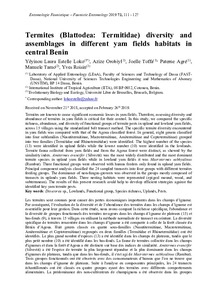| dc.contributor.author | Loko, Y.L.E. |
| dc.contributor.author | Orobiyi, A. |
| dc.contributor.author | Toffa, J. |
| dc.contributor.author | Agre, P. |
| dc.contributor.author | Tamo, M. |
| dc.contributor.author | Roisin, Y. |
| dc.date.accessioned | 2020-08-06T12:28:51Z |
| dc.date.available | 2020-08-06T12:28:51Z |
| dc.date.issued | 2019 |
| dc.identifier.citation | Loko, Y.L.E., Orobiyi, A., Toffa, J., Agre, P., Tamo, M. & Roisin, Y. (2019). Termites (Blattodea: Termitidae) diversity and assemblages in different yam fields habitats in central Benin. Entomologie Faunistique - Faunistic Entomology, 72, 111-127. |
| dc.identifier.issn | 2030-6318 |
| dc.identifier.uri | https://hdl.handle.net/20.500.12478/6916 |
| dc.description.abstract | Termites are known to cause significant economic losses in yam fields. Therefore, assessing diversity and abundance of termites in yam fields is critical for their control. In this study, we compared the specific richness, abundance, and diversity of functional groups of termite pests in upland and lowland yam fields, across 15 villages using the standardized belt transect method. The specific termite diversity encountered in yam fields was compared with that of the Agoua classified forest. In general, eight genera classified into four subfamilies (Nasutitermitinae, Macrotermitinae, Amitermitinae and Coptotermitinae) grouped into two families (Termitidae and Rhinotermitidae) were identified. The highest number of the species (13) were identified in upland fields while the lowest number (10) were identified in the lowlands. Termite fauna collected from yam fields and from the Agoua forest were distinct, as showed by the similarity index. Amitermes evuncifer (Silvestri) was the most widely distributed and the most dominant termite species in upland yam fields while in lowland yam fields it was Macrotermes subhyalinus (Rambur). Three functional groups were observed with humus feeders only found in upland yam fields. Principal component analysis classified the 24 sampled transects into four groups with different termites feeding groups. The dominance of non-fungus-growers was observed in the groups mostly composed of transects in uplands yam fields. Three nesting habitats were represented (epigeal mound, wood, and subterranean). The results of this present research could help to develop efficient strategies against the identified key yam termite pests. |
| dc.format.extent | 111-127 |
| dc.language.iso | en |
| dc.subject | Dioscorea |
| dc.subject | Pests |
| dc.subject | Yams |
| dc.subject | Isoptera |
| dc.subject | Pests of Plants |
| dc.subject | Termites |
| dc.title | Termites (Blattodea: Termitidae) diversity and assemblages in different yam fields habitats in central Benin |
| dc.type | Journal Article |
| cg.contributor.crp | Grain Legumes |
| cg.contributor.crp | Roots, Tubers and Bananas |
| cg.contributor.affiliation | National University of Sciences Technologies Engineering and Mathematics of Abomey |
| cg.contributor.affiliation | International Institute of Tropical Agriculture |
| cg.contributor.affiliation | Université Libre de Bruxelles |
| cg.coverage.region | Africa |
| cg.coverage.region | West Africa |
| cg.coverage.country | Benin (Dahomey) |
| cg.coverage.hub | Headquarters and Western Africa Hub |
| cg.researchtheme | Plant Production and Health |
| cg.identifier.bibtexciteid | LOKO:2019c |
| cg.isijournal | ISI Journal |
| cg.authorship.types | CGIAR and developing country institute |
| cg.iitasubject | Agronomy |
| cg.iitasubject | Food Security |
| cg.iitasubject | Pests of Plants |
| cg.iitasubject | Plant Production |
| cg.iitasubject | Yam |
| cg.journal | Entomologie Faunistique |
| cg.notes | Open Access Journal |
| cg.accessibilitystatus | Open Access |
| cg.reviewstatus | Peer Review |
| cg.usagerightslicense | Creative Commons Attribution 4.0 (CC BY 0.0) |
| cg.targetaudience | Scientists |
| cg.identifier.doi | https://dx.doi.org/10.25518/2030-6318.4621 |
| cg.iitaauthor.identifier | Paterne AGRE: 0000-0003-1231-2530 |
| cg.iitaauthor.identifier | Manuele Tamò: 0000-0002-5863-7421 |

